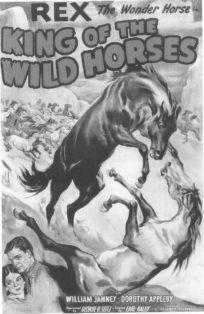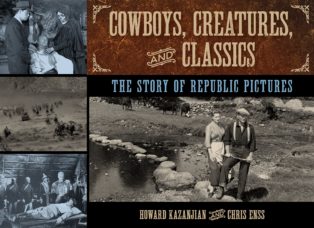Enter now to win a copy of
Cowboys, Creatures and Classics: The Story of Republic Pictures

The serial work producer Nat Levine was doing was extremely popular. Audiences flocked to theaters each week to find out how cowboy heroes like Johnny Mack Brown, Ken Maynard, and Tom Mix fared against the bad guys and to learn if equine stars like Rex, the King of Wild Horses, and canine actor Rin Tin Tin managed to save their pal Smiley Burnette from the villainous Harry Woods. Levine wanted to expand his moviemaking and looked to acquire the Mack Sennett production lot and facilities in order to make it happen. He approached Monogram Pictures’ executives Trem Carr and W. Ray Johnston about a merger. Neither was interested in combining his resources to purchase Mack Sennett. Both men felt the cost to run such a business would be too much to sustain. Yates heard about Levine’s proposal and offered to finance the deal. With Yates’ considerable wealth behind the enterprise and the promise that the two could share the responsibility of studio chief, Carr and Johnston decided to participate. The owners of Liberty and Majestic Studios also agreed to merge with Mascot and Monogram. The talent and resources of each small motion picture company were pooled and a distribution arm was also added to the corporation.
Republic Pictures was born in June 1935. As the money behind the venture, Yates wasted no time in asserting his authority. Although Johnston and Carr were installed as managers, Yates made it clear that he would make all major decisions regarding the company. The two executives were outraged by the mogul’s behavior but were compelled to stay with the new studio because they now lacked the means to start their own business. Nat Levine clashed with Yates, too, but chose to keep quiet in favor of making movies. He churned out a number of modest yet successful films during the first four years Republic was in operation.
Undeterred by the conflicts with his managing staff, Yates announced in a press conference with his top personnel that Republic Pictures would produce fifty-two films a year. Edward A. Golden, general sales manager for the studio, added that the company would strive to make exceptional pictures and cited problems with finances in the industry as a whole for the reason some companies delivered inferior products. Johnston shared his belief that not only financing played a part but that the lack of quality material was a contributing factor to bad movies being made. Johnston outlined Republic Pictures’ program to produce classics and the works of famous authors and urged American authors to “write better stories for screen production.”
Throughout the summer of 1935, Republic Pictures and its qualified staff made news. Stories about the ambitious independent studio’s line of pictures and the controversial comments about the industry appeared on the front pages of the newspapers. Johnston, an actor in his early days in Hollywood and a member of Franklin Roosevelt’s motion picture code authority, had definite thoughts about the salary lead actors at Republic should expect to earn. “Stars of today are paid according to their drawing power,” he told the Associated Press. “What they get is all right if they bring it back through the box office. Many of them don’t do that, however. We at Republic Pictures will pay according to the draw.”

To learn more about the many films Republic Pictures produced read
Cowboys, Creatures and Classics: The Story of Republic Pictures

